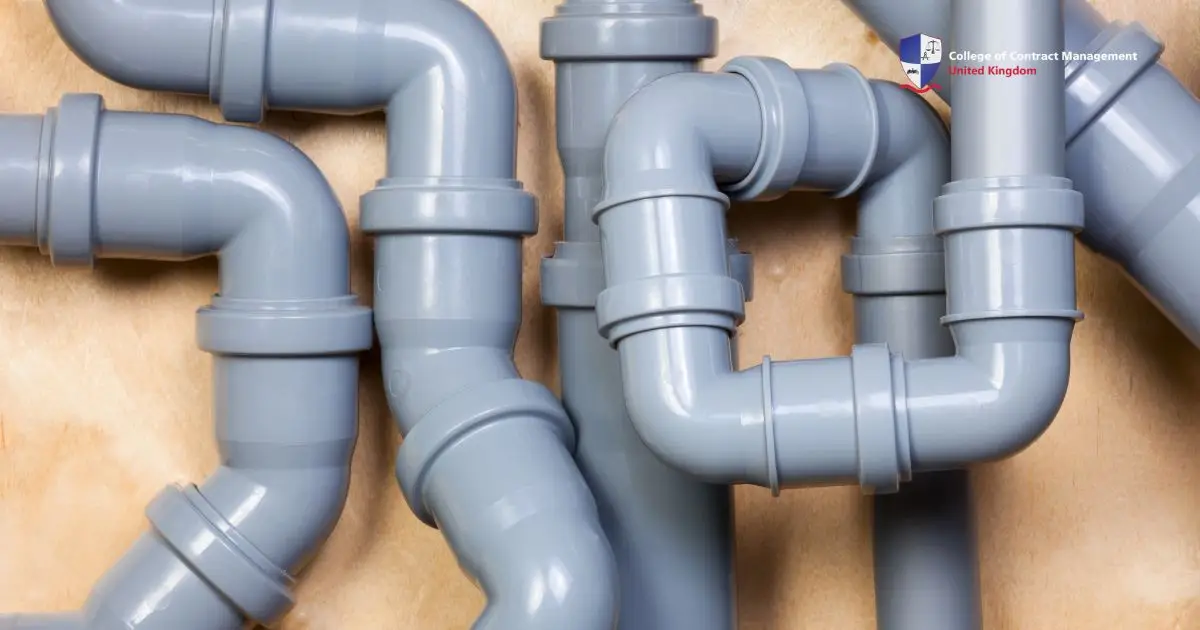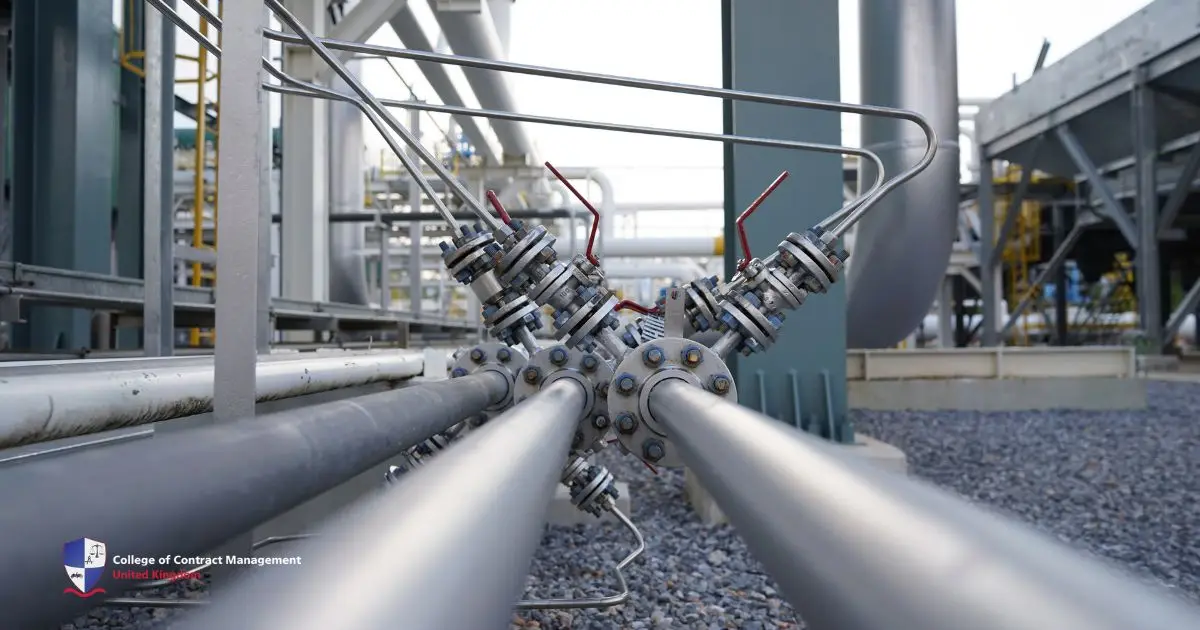One of the most important things in the construction and plumbing industries is Polyvinyl Chloride or PVC pipe. This pipe is among the most commonly used plastics in the world. It offers many benefits and is very versatile. It is affordable, recyclable, and lightweight, making them very effective.
This pipe mainly carries water in systems like plumbing and water supply, drainage and stormwater systems, and many others. People also use this pipe for electrical wiring protection, fencing, or structural uses such as temporary structures or HVAC systems.
What is a PVC Pipe?
PVC pipe is made from a plastic called polyvinyl chloride plastic. Normally, this pipe is rigid and brittle. However, when combined with additives like plasticisers, the pipe becomes stronger and more flexible. These pipes are usually mixed with stabilisers, lubricants, flame retardants, and other chemicals.
In 1872, German chemist Gottlieb Schall discovered how to make PVC. He turned it into a solid form. Unfortunately, it was a white brittle powder that was not practical to use. In the 1920s, the B.F.Goodrich Company in the United States made a breakthrough. They turned PVC into a more useful form, making it suitable for a wide range of applications. Until today, people still develop this kind of pipe in a better state.
People mostly use this pipe to transport water, such as in plumbing and irrigation. This pipe is great for transporting water because it is resistant to corrosion, non-toxic, and lightweight. The pipe also lasts a long time and is easy to handle. Not only transports water, but it has other uses such as electrical insulation, medical tubing, flooring, furniture, and many more.
Types of PVC Pipe
There are five different variants of this pipe. Specific applications are based on the material, strength, and performance in different environments. Also, it has its advantages and disadvantages. That is why you should understand their difference before choosing one. Here are the types of PVC Pipe:
1. PVC-U (Unplasticised Polyvinyl Chloride)
This type of PVC does not contain plasticisers like other substances. This means the material is rigid and does not have the flexibility or softness that some other forms might have. It is common and widely used for piping systems. Sometimes, people call this variant rigid PVC.
The characteristics of PVC-U are rigid and strong. This kind of pipe could withstand physical stress, high pressure, or even heavy-duty conditions. This pipe is the best solution to handle rust and chemicals as it has resistance to them. PVC-U will not corrode when exposed to water, moisture, or chemicals. Also, it is resistant to many acids, alkalis, and salts.
Advantages
- Durability: Resistant to corrosion, wear, and chemical exposure.
- Cost-effective: PVC-U and other PVC pipes are relatively cheaper than metal alternatives, such as copper or steel.
- Low Maintenance: It has a long lifespan and requires little upkeep.
- Easy Installation: Easy to cut and join and lightweight, reducing installation time and labour costs.
- Non-toxic: Safe usage in potable water systems and non-toxic in most applications.
Disadvantages
- Temperature Sensitivity: PVC pipe is not suitable for high or low-temperature applications where the recommended maximum operating temperature is 0℃ to 60℃.
- Brittleness in Cold Weather: Although it has good durability, PVC-U can become brittle in low temperatures, which could crack or break under stress.
- Sensitive to UV: This type of pipe could degrade under sunlight or UV radiation, which could make the pipe fragile.
Common Uses
- Water Supply Systems: It is safe for potable water and does not leach harmful substances. For example, irrigation systems use rigid PVC pipes.
- Sewage Systems: As it is corrosion-resistant and durable, this kind of pipe could be used for drainage, sewer lines, and stormwater management systems.
- Industrial Applications: It will do the job of carrying chemicals and liquids that are non-corrosive or mildly corrosive in the chemical processing and pharmaceuticals industry.
- Ventilation Systems: Not only does PVC-U carry water, but it is also used to carry gases and air from drain systems in plumbing systems.
- Electrical Conduit: The rigidness of this type of pipe could help safeguard wiring and cables from physical damage.
2. CPVC (Chlorinated Polyvinyl Chloride)
It is pretty similar to PVC, but it has extra treatment. Additional chlorine molecules are commonly added during its manufacturing process. As a result, it could handle higher temperatures than other variants of PVC pipe. Plumbing and industrial applications, where higher temperature resistance is essential when using CPVC.
Advantages
- Heat Resistance: This PVC pipe can withstand high temperatures up to 93℃.
- Chemical Resistance: This kind of PVC is resistant to many chemicals, which is very useful for industrial, chemical, and wastewater applications.
- Durability and Longevity: CPVC also has high durability and is long-lasting as it is resistant to corrosion, cracks, and damage over time.
- Low Maintenance: It could reduce a great amount of costs since it requires minimal maintenance over its lifetime.
- Non-toxic: Although it is mainly used in industrial, chemical, and wastewater applications, CPVC is also safe for potable water systems.
Disadvantages
- Brittleness in extreme cold: Just because it has high heat resistance does not mean this kind of pipe could handle extremely cold temperatures where it could become fragile.
- Sensitive to UV: Just like PVC-U, prolonged exposure to UV rays or sunlight could degrade the pipe.
- Limited flexibility: CPVC has a limited ability to bend, which requires joints and fitting to make it usable.
- Can be damaged by solvents: As strong as it is, this type of pipe cannot handle harsh chemicals or incompatible adhesives, which could weaken the material.
Common Uses
- Hot Water Plumbing: As it has high heat resistance, it is the best choice for residential and commercial hot water systems.
- Industrial Applications: CPVC will do its job of transporting hot liquids or chemicals. It is usually found in the chemical processing, pharmaceutical, and food and beverage industries.
- Fire Sprinkler Systems: Because it resists high temperatures, this type of PVC pipe is ideal for fire sprinkler systems.
- Pool Plumbing: It can be found in swimming pool plumbing due to its ability to handle chlorinated water and the temperature of heated pools without degrading the pipe’s durability.
3. PVC-O (Oriented Polyvinyl Chloride)
This variant of PVC pipe has a unique manufacturing process called orienting or stretching. Through that process, the pipe is going to be stronger, more durable, and resistant to pressure and impact than regular PVC. Usually, this kind of pipe can be found where the applications need high-strength piping systems like water distribution, irrigation, and some industrial processes.
Advantages
- Higher Strength: After going through the orientation process, PVC-O is significantly stronger than regular PVC pipe, which is suitable for high-pressure applications.
- Impact Resistance: The same process made the pipe more resistant to impact.
- Corrosion-resistant: This type of pipe is also resistant to corrosion, which makes it ideal for transporting chemicals and water.
- Stiffness: PVC-O has higher rigidity due to the alignment of the polymer chains, which helps resist deformation when under pressure.
Disadvantages
- Temperature Limitation: Even though it can handle high pressure and impact, temperature could be the problem. Just like regular PVC pipe, this kind of pipe cannot handle temperatures above 60℃ or lower than 0℃.
- UV Sensitivity: PVC-O could not handle continuous exposure to UV radiation or sunlight, which could make the pipe fragile.
- Expensive: It costs around £3.40 for the 1-metre length of 25 mm metric PVC-O.
Common Uses
- Water Distribution Systems: PVC-O is mainly used for pressurised water distribution systems, including municipal water supply networks, due to its ability to handle high pressure.
- Industrial Application: Enhanced strength and resistance to many chemicals make this pipe one of the best options for industrial applications to transport chemicals, industrial fluids, or high-pressure liquids.
- Pressure Mains: PVC-O is also ideal for pressure mains in sewage systems or stormwater systems where high pressure and durability are essential.
4. PVC-M (Modified Polyvinyl Chloride)
PVC-M is more flexible than other types of PVC pipe. That flexibility comes from adding more substances to modify the polymer’s structure. It also has better strength, impact resistance, and flexibility than PVC-U but is not as strong as PVC-O.
Advantages
- Improved Flexibility: Has more flexibility than other PVC pipes due to modification through adding more additives.
- Increased Toughness: This type of pipe is tougher than PVC-U but not as tough as PVC-O.
- Good for Medium Pressure Applications: Not as strong as PVC-O, but PVC-M could handle medium pressure.
Disadvantages
- Temperature Limitations: Just like other PVC, except CPVC, this type of PVC pipe has temperature limitations where it cannot handle temperatures above 60℃ or lower than 0℃.
- Sensitive to UV: PVC-M cannot be exposed to UV light or sunlight. It's best to avoid prolonged exposure, as it leads to degrading.
Common Uses
- Irrigation Systems: In agricultural irrigation systems, this pipe is the most ideal since it requires flexibility and strength while being exposed to pressure and environmental stresses.
- Sewage and Wastewater Systems: Other than being resistant to many chemicals and corrosive environments, PVC-M could handle external pressure or impact, too. Gravity-fed and pressurised sewer systems are commonly using this type of PVC pipe.
5. PVC-A (Amorphous Polyvinyl Chloride)
PVC-A is different from the other four types. This PVC pipe has an amorphous (non-crystalline) structure. A special type of PVC that is more flexible but weaker. It is suitable for specific applications that require clarity and more flexibility. However, due to its amorphous structure, this type has lower strength than the others.
Advantages
- Transparency: PVC-A is more transparent than PVC variants. It is ideal for applications where clarity is important, such as in visual inspection or display applications.
- Flexibility: The amorphous structure makes this variant more flexible than rigid, just like the other PVC types.
Disadvantages
- Lower Strength: Unfortunately, due to its amorphous structure, PVC-A has become weaker than any other variant of PVC pipe.
Common Uses
- Clarity-based Applications: This type of PVC can usually be found in medical devices, food packaging, and any other applications where visual clarity is essential.
- Window and Display Frames: Even though strength is not the best trait of PVC-A, it still could be used as window frames and display applications. Where transparency and ease of moulding make it useful.
Conclusion
Knowing the difference between each type of PVC pipe is very important since they have different functions and advantages or disadvantages. You can then identify which kind of pipe is best for your own use or business. With it, you'll save time, money, and energy.
However, managing your time, money, and energy more efficiently also requires an understanding of important concepts like contracts and project management. This will help you to avoid overspending on your budget. If you are interested in improving these skills, you have to consider joining a course with the College of Contract Management which will help you gain the skills and knowledge needed to do so.



